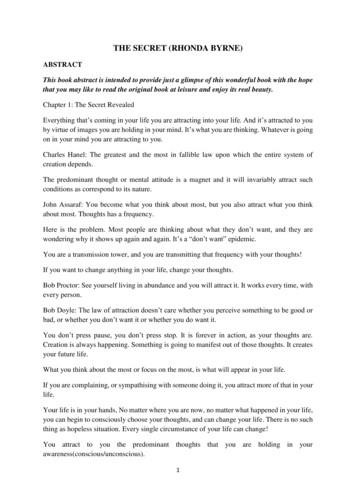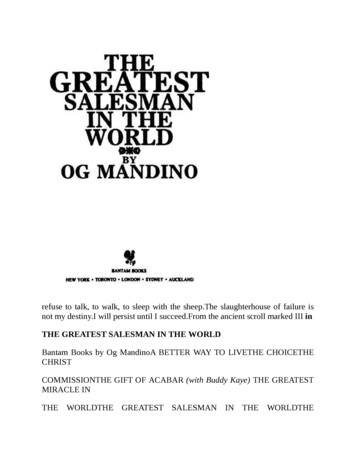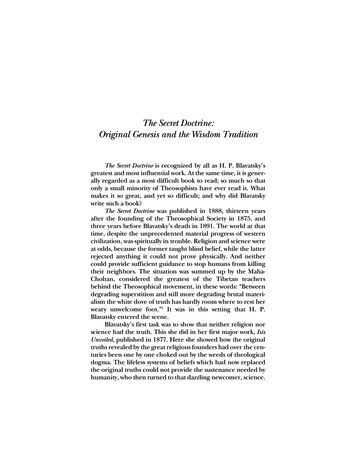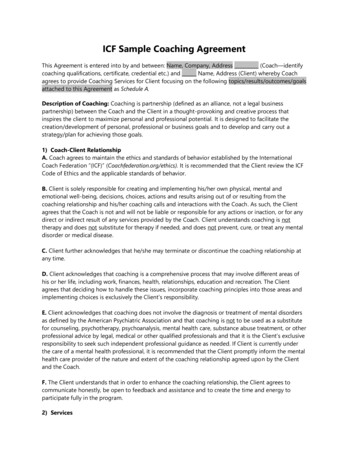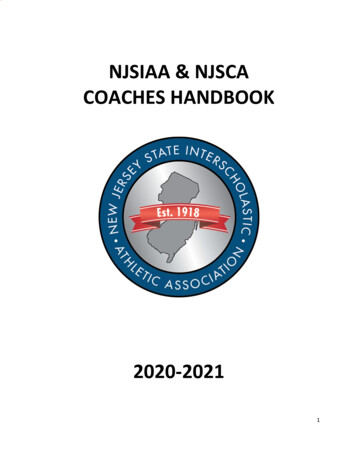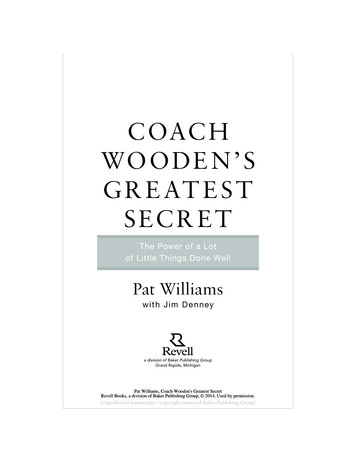
Transcription
COAC HWOODE N ’ SGR E AT E STSEC R ETThe Power of a Lotof Little Things Done WellPat Williamswith Jim D e nneyOPat Williams, Coach Wooden's Greatest SecretRevell Books, a division of Baker Publishing Group, 2014. Used by permission.(Unpublished manuscript—copyright protected Baker Publishing Group)Williams Wooden KK djm.indd 310/9/13 4:01 PM
2014 by Pat WilliamsPublished by Revella division of Baker Publishing GroupP.O. Box 6287, Grand Rapids, MI 49516-6287www.revellbooks.comPrinted in the United States of AmericaAll rights reserved. No part of this publication may be reproduced, stored in a retrievalsystem, or transmitted in any form or by any means—for example, electronic, photocopy,recording—without the prior written permission of the publisher. The only exceptionis brief quotations in printed reviews.Library of Congress Cataloging-in-Publication Data is on file at the Library of Congress, Washington, DC.ISBN 978-0-8007-2276-0Scripture quotations are from the Holy Bible, New International Version . NIV .Copyright 1973, 1978, 1984, 2011 by Biblica, Inc. Used by permission of Zondervan.All rights reserved worldwide. www.zondervan.com141516 171819207654321Pat Williams, Coach Wooden's Greatest SecretRevell Books, a division of Baker Publishing Group, 2014. Used by permission.(Unpublished manuscript—copyright protected Baker Publishing Group)Williams Wooden KK djm.indd 410/9/13 4:01 PM
Toour two latest grandchildren,twin boys, Benjamin and DeaconMay the life principles of Coach Wooden’s greatest secretbecome a part of their lives at an early age.“It’s the little details that are vital. Little things make big thingshappen.”Coach John WoodenPat Williams, Coach Wooden's Greatest SecretRevell Books, a division of Baker Publishing Group, 2014. Used by permission.(Unpublished manuscript—copyright protected Baker Publishing Group)Williams Wooden KK djm.indd 510/9/13 4:01 PM
Pat Williams, Coach Wooden's Greatest SecretRevell Books, a division of Baker Publishing Group, 2014. Used by permission.(Unpublished manuscript—copyright protected Baker Publishing Group)Williams Wooden KK djm.indd 610/9/13 4:01 PM
ContentsForeword 9Acknowledgments 13Introduction: Little Things Make Big ThingsHappen 151. Little Things Are Fundamental to Achievement 252. Little Things Lead to Simplicity—and Success 433. Little Things Prepare You for Great Things 634. Little Things Are the Key to Achieving Your Goals 795. Little Things Produce Consistency 976. Little Things Lead to Excellence 1137. Little Things Guard Your Character 1278. Little Things Yield a Habit of Success 143Epilogue: Life Is All about the Little Things 165Appendix 1: Additional Resources 169Appendix 2: Little Things Build a Big Legacy 173Notes 1817Pat Williams, Coach Wooden's Greatest SecretRevell Books, a division of Baker Publishing Group, 2014. Used by permission.(Unpublished manuscript—copyright protected Baker Publishing Group)Williams Wooden KK djm.indd 710/9/13 4:01 PM
Pat Williams, Coach Wooden's Greatest SecretRevell Books, a division of Baker Publishing Group, 2014. Used by permission.(Unpublished manuscript—copyright protected Baker Publishing Group)Williams Wooden KK djm.indd 810/9/13 4:01 PM
ForewordIhad the great thrill and honor of being apart of two NBA championship teams, in 1999 and 2003.Yet I think the honor I received in 2004, after I retired,may have been even greater: The Keys to Life Award, personally presented to me by one of my all-time heroes, Coach JohnWooden. The award is given to those who aspire to follow CoachWooden’s Seven Keys to Life:1. Be true to yourself.2. Help others.3. Make each day your masterpiece.4. Drink deeply from good books, especially the Bible.5. Make friendship a fine art.6. Build a shelter against a rainy day.7. Pray for guidance and give thanks for your blessings everyday.Coach John Wooden has always been one of my role models.From observing his life and his coaching style, I learned thatit is possible to be intensely competitive, to be a winner and a9Pat Williams, Coach Wooden's Greatest SecretRevell Books, a division of Baker Publishing Group, 2014. Used by permission.(Unpublished manuscript—copyright protected Baker Publishing Group)Williams Wooden KK djm.indd 910/9/13 4:01 PM
Forewordchampion, and still be a person of integrity, humility, character,and faith. No coach ever won more championships than CoachWooden, and no one was ever more giving and caring and unassuming than Coach Wooden.In his entire coaching career, Coach John Wooden only hadone losing season—his very first season coaching at the highschool level. After that, he was all about winning. At UCLAhe won 620 games in 27 seasons, had a record winning streakof 88 consecutive wins, had 4 perfect 30–0 seasons, won 98consecutive home games at UCLA’s Pauley Pavilion, and won10 NCAA titles in 12 seasons.Coach Wooden won when he had superstars on his team.But he also won when there were no superstars, when most ofhis starters had graduated and would not be returning. All ofthose wins and championships were not merely the result ofa superstar roster. There was something special about CoachWooden himself, about the way he coached, about the principleshe taught, about the values he instilled in his players.He had a secret formula for success. Well, it wasn’t reallymuch of a secret. If you asked him, he would readily tell you.The key to his success, he said, was a lot of little things donewell. If you would focus on the little things that escaped thenotice of your opponents and competitors, you would have aslight edge over them—and that would be your winning edge.In this book, Pat Williams, the cofounder and senior vicepresident of the Orlando Magic, has unpacked and exploredCoach John Wooden’s greatest success secret so that we can allfollow the example of the greatest coach of all time. In thesepages, Pat examines every facet of Coach Wooden’s formulafor success. You’ll discover how focusing on the little thingswill prepare you for great things. These principles will help tosafeguard your character and produce habits of consistency andexcellence in your life.10Pat Williams, Coach Wooden's Greatest SecretRevell Books, a division of Baker Publishing Group, 2014. Used by permission.(Unpublished manuscript—copyright protected Baker Publishing Group)Williams Wooden KK djm.indd 1010/9/13 4:01 PM
ForewordSuccess, winning, achievement, influence, leadership—theseare big things. But they are the result of a lot of little things donewell. Whatever your dreams and goals, whatever your field ofendeavor, whatever you hope to achieve in life, this book willspeed you on your journey.David Robinsontwo-time NBA world champion, San Antonio Spurs;founder, IDEA Carver (formerly Carver Academy), San Antonio;cofounder, Admiral Capital Group11Pat Williams, Coach Wooden's Greatest SecretRevell Books, a division of Baker Publishing Group, 2014. Used by permission.(Unpublished manuscript—copyright protected Baker Publishing Group)Williams Wooden KK djm.indd 1110/9/13 4:01 PM
Pat Williams, Coach Wooden's Greatest SecretRevell Books, a division of Baker Publishing Group, 2014. Used by permission.(Unpublished manuscript—copyright protected Baker Publishing Group)Williams Wooden KK djm.indd 1210/9/13 4:01 PM
AcknowledgmentsWith deep appreciation I acknowledgethe support and guidance of the following peoplewho helped make this book possible.Special thanks to Alex Martins, Dan DeVos, and Rich DeVosof the Orlando Magic.Hats off to my associate Andrew Herdliska; my proofreader,Ken Hussar; and my ace typist, Fran Thomas.Thanks also to my writing partner, Jim Denney, for his superbcontributions in shaping this manuscript.Hearty thanks also go to Andrea Doering, senior acquisitions editor at Revell Books, and to the entire Revell team fortheir vision and insight and for believing that we had somethingimportant to say in these pages.And, finally, special thanks and appreciation go to my wife,Ruth, and to my wonderful and supportive family. They aretruly the backbone of my life.13Pat Williams, Coach Wooden's Greatest SecretRevell Books, a division of Baker Publishing Group, 2014. Used by permission.(Unpublished manuscript—copyright protected Baker Publishing Group)Williams Wooden KK djm.indd 1310/9/13 4:01 PM
Pat Williams, Coach Wooden's Greatest SecretRevell Books, a division of Baker Publishing Group, 2014. Used by permission.(Unpublished manuscript—copyright protected Baker Publishing Group)Williams Wooden KK djm.indd 1410/9/13 4:01 PM
IntroductionLit tle Things Make Big Things HappenBig things are accomplished only through the perfection of minordetails.Coach John WoodenIn July 2000, I checked my voice mail and hearda message that changed my life. “Mr. Williams,” the callersaid, “this is John Wooden, former basketball coach atUCLA.” I was amazed that the greatest coach in the history ofcollege basketball thought he needed to explain to me who hewas.Coach Wooden went on to give his personal recommendation for a UCLA trainer who had applied for a position withthe Orlando Magic. He ended the message by saying, “I enjoyreading your books very much. Good-bye.”I returned his call, and we had a wonderful chat. It was thefirst of many encounters I was to have with Coach John Woodenin the years to come. A few months later, as I was thinking about15Pat Williams, Coach Wooden's Greatest SecretRevell Books, a division of Baker Publishing Group, 2014. Used by permission.(Unpublished manuscript—copyright protected Baker Publishing Group)Williams Wooden KK djm.indd 1510/9/13 4:01 PM
Introductionwriting a book called How to Be like Coach Wooden, I wrote tohim and asked for his blessing on the project. A few days later,he called and again said, “Mr. Williams, this is John Wooden,former basketball coach at UCLA.”I thought, Coach, I truly do know who you are!“I received your letter,” he said, “and even though I’m notworthy of a project like this, if you would like to write thisbook, you go right ahead.”That was the beginning of my friendship with CoachWooden—a friendship that resulted in a series of books abouthis life and his philosophy. I followed How to Be like CoachWooden (2006) with Coach Wooden: The Seven Principles ThatShaped His Life and Will Change Yours (2011) and this book,Coach Wooden’s Greatest Secret.During the last decade of his life, Coach Wooden invited meinto his life in an extraordinary way. Not only did I have manyrewarding conversations with him, but I also interviewed literally hundreds of people who knew him and had great storiesto tell and insights to share. As I got to know Coach Wooden,as I heard story after story about him, it occurred to me that ifeveryone in the world was more like him, this world would bealmost problem-free.A number of times, I went to Coach’s condo in Encino, California, to pick him up and take him out to dinner. At five o’clocksharp, we’d head out to the Valley Inn, Coach Wooden’s favoritedining spot, located in Sherman Oaks. We’d arrive in time forthe Early Bird Special. His favorite item on the menu was theValley Inn’s famous clam chowder.As we conversed over dinner, I was always impressed by theclarity of Coach Wooden’s thinking, the depth of his wisdom,and the quickness of his gentle sense of humor. You soon forgotthat you were talking to a man in his nineties, because he hadthe mind of a much younger man.16Pat Williams, Coach Wooden's Greatest SecretRevell Books, a division of Baker Publishing Group, 2014. Used by permission.(Unpublished manuscript—copyright protected Baker Publishing Group)Williams Wooden KK djm.indd 1610/9/13 4:01 PM
IntroductionMark Gottfried, a former assistant at UCLA, now the headbasketball coach at North Carolina State, once told me, “Whenever you’re with Coach Wooden, you’d better have a catcher’smitt on. You never know when Coach might toss you an important wisdom principle, so you’d better be ready to snag it.”I also found out, in my conversations with Coach, that itwasn’t enough to be a good listener. I had to have my thinkingcap on whenever I was around him. Coach was a consummateeducator, teacher, and mentor. He favored the Socratic methodof asking questions and challenging your answers in order toforce you to think. Many times, he would pepper me with probing questions. Whether I was answering his questions or he wasanswering mine, it was always a profound learning experiencefor me.At one of our dinners together, I was fortunate to have bothmy thinking cap and my catcher’s mitt on. I asked him, “Coach,if you could pinpoint just one secret of success in life, whatwould it be?”Coach would never give a glib or superficial answer. If youasked him a thoughtful question, he would take a few momentsto think through what he wanted to say. He was constantly awareof his influence, and he always wanted to give people the verybest of his wisdom. As I waited for his answer, I found myselfleaning closer, anticipating his insight, not wanting to miss asingle syllable.He said, “The closest I can come to one secret of success isthis: a lot of little things done well.”That was a eureka moment for me.I have given hundreds of speeches and have written dozensof books on success and motivation. Yet, in that one magicalmoment, in a single seven-word phrase, Coach Wooden crystallized everything I have been trying to communicate for decades:a lot of little things done well.17Pat Williams, Coach Wooden's Greatest SecretRevell Books, a division of Baker Publishing Group, 2014. Used by permission.(Unpublished manuscript—copyright protected Baker Publishing Group)Williams Wooden KK djm.indd 1710/9/13 4:01 PM
IntroductionThe Difference between Winning and LosingCoach John Wooden was the greatest coach who ever lived.That’s not just my opinion. That’s the consensus throughoutthe sports world.In July 2009, the Sporting News published a ranking of thefifty greatest coaches of all time, in every sport, at every level,both collegiate and professional. The ranking was made by ablue-ribbon committee of sportswriters, coaches, and top athletes. The number one coach on that list was John Wooden,followed by Vince Lombardi and Bear Bryant. During his tenure as head basketball coach of the UCLA Bruins (1948–75),Coach John Wooden won ten NCAA national championshipsin a twelve-year period, including seven championships in a row.During that time, his Bruins won a record eighty-eight gamesin a row. His record is unprecedented and is likely to stand aslong as the game of basketball is played.Coach Wooden is remembered for the many inspirationaltalks and motivational tools he gave his players, especially hisPyramid of Success. He was also famed for never screaming,never cussing, never berating his players but always speakingcalmly yet firmly. His players didn’t fear his wrath, but theyfeared disappointing him. They loved him, and out of that love,they played their hearts out for him.One of Coach Wooden’s most famous and accomplishedplayers was Kareem Abdul-Jabbar (known during his collegedays as Lew Alcindor). Kareem wrote these words of tributeto Coach Wooden in a December 2000 op-ed for the New YorkTimes:Thirty-five years ago, I walked into John Wooden’s office atUCLA and began a special relationship that has enriched mylife. . . . He was soft-spoken and serious, yet his caring demeanordrew me to him. He always called me Lewis, not Lew or Lewie,18Pat Williams, Coach Wooden's Greatest SecretRevell Books, a division of Baker Publishing Group, 2014. Used by permission.(Unpublished manuscript—copyright protected Baker Publishing Group)Williams Wooden KK djm.indd 1810/9/13 4:01 PM
Introductionthe way everyone else did back then. Today, he calls me Kareem,although sometimes he slips up and calls me Lewis.He was more a teacher than a coach. He broke basketballdown to its basic elements. He always told us basketball was asimple game, but his ability to make the game simple was partof his genius.I never remember him yelling on the court, but there was noneed because he never had trouble getting his point across. Iremember a close game in my sophomore year against ColoradoState. During timeouts, his instructions were clear and precise.I had never doubted him before, but when the game ended, itwas obvious he had been thinking three moves ahead of us, calmand cool as always.1Coach Wooden always seemed to think three moves aheadof everyone else. Whenever I was with him, I felt like I was astudent and he was the master, the mentor, the teacher. And ifI needed insight, I needed only to lower my bucket into the wellof his wisdom, and there would always be plenty of insight todraw from.So on that evening when he told me that the key to successin life is “a lot of little things done well,” I felt I had falleninto a gold mine. Those seven words matched up exactly witheverything I had experienced in my own journey toward success—and they matched up with the experiences of successfulpeople in many fields.Miami Heat shooting guard Dwyane Wade was named 2006Sportsman of the Year by Sports Illustrated. He helped leadthe Heat to two NBA championships (2006 and 2012). He alsohelped lead the 2008 United States men’s basketball “RedeemTeam” to a gold medal in the 2008 Beijing Summer Olympics.He ascribes his success to little things, saying, “Guys who mightnot be superstars, but because of their hustle, because of thelittle things they do, these are the guys who can really mean thedifference between winning and losing.”219Pat Williams, Coach Wooden's Greatest SecretRevell Books, a division of Baker Publishing Group, 2014. Used by permission.(Unpublished manuscript—copyright protected Baker Publishing Group)Williams Wooden KK djm.indd 1910/9/13 4:01 PM
IntroductionSwimmer Ryan Lochte, who won two Olympic gold medals inBeijing and two more gold medals in the 2012 London SummerOlympics, also says that the difference between winning andlosing is the little things: “I’m going to focus on speed, doinglittle things like my turns and my starts—just speed.”3But the little things are also important in fields that have nothing to do with athletic competition. Sir Roger Penrose is an Englishmathematical physicist. He shared the 1988 Wolf Prize for physicswith Stephen Hawking. He once explained that the discovery of agrand scientific principle often takes place not as a sudden, hugerevelation but as a series of small inklings, one idea building ontop of another. “People think of these eureka moments,” he oncesaid, “and my feeling is that they tend to be little things, a littlerealization, and then a little realization built on that.”4Bruce Barton was an advertising executive, the cofounder ofthe Batten, Barton, Durstine & Osborn (BBDO) agency. He invented Betty Crocker and named the companies General Electricand General Motors. He also served as a two-term congressmanfrom the state of New York. Barton once observed, “Sometimeswhen I consider what tremendous consequences come from littlethings, I am tempted to think there are no little things.”5Samuel Johnson, the eighteenth-century English writer andliterary critic, has been called “the most distinguished man ofletters in English history.” He understood the importance oflittle things to the art of living well. He once wrote, “Thereis nothing, Sir, too little for so little a creature as man. It is bystudying little things that we attain the great art of having aslittle misery and as much happiness as possible.”6The Little Things within the Big PictureNCAA coaching legend Dean Smith coached men’s basketballfor thirty-six years (1961–97) at the University of North Carolina20Pat Williams, Coach Wooden's Greatest SecretRevell Books, a division of Baker Publishing Group, 2014. Used by permission.(Unpublished manuscript—copyright protected Baker Publishing Group)Williams Wooden KK djm.indd 2010/9/13 4:01 PM
Introductionat Chapel Hill, retiring with 879 victories to his credit. DaveOdom, who coached basketball at Wake Forest, recalls the warmups before a game between his Wake Forest Demon Deaconsand Dean Smith’s Tar Heels.“I saw a couple of [Dean Smith’s] assistants watching theteam do layups and writing something down,” Odom said. “Iwas curious and asked what they were doing. Turns out theywere charting the layups. If any were missed, [Smith] addressedthat in practice the next day. At first, I thought he was crazy,but then I realized that here was a man who devoted himself toevery possible facet of the game.” In other words, Dean Smithwas focused on the little things that can make the differencebetween winning and losing.7Charles Walgreen (1873–1939) was an American businessmanand founder of the Walgreens drugstore chain. It was a littlething—part of his finger—that led to him becoming a drugstoremogul. At age sixteen, he was working in a shoe factory, operating a machine that cut leather for shoes. His hand slipped, andhe cut off the top joint of one of his fingers. The doctor whotreated him persuaded him to take a job as an apprentice forlocal pharmacist D. S. Horton. As a result of his employment,Walgreen became fascinated with the drugstore trade. By thetime he was twenty-eight, he owned his own pharmacy in Chicago. Fifteen years later, he owned nine stores. Ten years afterthat, he owned more than one hundred.Walgreen once wrote a book called Set Your Sales for Bigger Earnings, and he made sure that every sales employee ofhis drugstore empire received a copy. In that book, he wrote,“Success is doing a thousand little things the right way—doingmany of them over and over again.”8 Like Coach John Wooden,like Dwyane Wade and Ryan Lochte, like Sir Roger Penrose andBruce Barton and Samuel Johnson, Charles Walgreen understood the importance of a lot of little things done well.21Pat Williams, Coach Wooden's Greatest SecretRevell Books, a division of Baker Publishing Group, 2014. Used by permission.(Unpublished manuscript—copyright protected Baker Publishing Group)Williams Wooden KK djm.indd 2110/9/13 4:01 PM
IntroductionWriting in Fast Company, Alan Cohen asks, “Why do somepeople succeed and others don’t? Two sports teams with equaltalent and the same records. One wins the championship andthe other doesn’t. Why? . . . What is the difference between beingsuccessful and being mediocre? It is taking the time to do thelittle things. It is that simple.”9Stanford business school professor and researcher RobertSutton reports that one of the distinguishing marks of a goodbusiness leader (a “good boss”) is that he or she is interested inthe little things, the details of the organization. An ineffectiveand arrogant business leader (a “bad boss”) is interested onlyin the big picture and considers the little things unworthy ofnotice. “Big picture” bosses, says Sutton, tend to “see generatingbig and vague ideas as the important part of their jobs—andto treat implementation, or pesky details of any kind, as mere‘management work’ best done by ‘the little people.’ . . . [They]avoid learning about people they lead, technologies their companies use, customers they serve, and numerous other cruciallittle things.”Sutton cites the example of a CEO of a major cellular phonecompany who made a series of disastrous product development and marketing decisions because all he cared about wasthe big picture. This CEO was out of touch with the featuresconsumers really wanted in their phones, the little things hiscustomers were looking for—so the marketplace rejected hiscompany’s products.By contrast, Sutton says, the late Apple CEO Steve Jobs wasable to envision the big picture while also maintaining a focuson the little things. From the time Apple opened its first AppleStore near Jobs’s home in Palo Alto, the CEO himself wouldoften visit the store. Sutton writes, “Jobs constantly fussed overdetails such as the quality of the shopping bags, where employees stood in the store, and the color of the walls and tables,22Pat Williams, Coach Wooden's Greatest SecretRevell Books, a division of Baker Publishing Group, 2014. Used by permission.(Unpublished manuscript—copyright protected Baker Publishing Group)Williams Wooden KK djm.indd 2210/9/13 4:01 PM
Introductionand what they conveyed about the brand.” One of the keys toSteve Jobs’s brilliance was his ability to focus on the little thingswithin the big picture.As Sutton concludes, “I am all for big ideas, visions, anddreams. But the best bosses do more than think big thoughts.They have a deep understanding of their industries, organizations, and teams, the people they lead, as well as other mundanethings. . . . This ability to go back and forth between the little details and the big picture is evident in the leaders I admire most.”10Leaders can delegate tasks and authority, but leaders cannotdelegate responsibility. A leader is responsible for every actionand decision made by the people under his command. Greatleaders build teams of creative self-starters, then empower theirpeople to make decisions. They set clear objectives and standards, then they check in often to make sure those objectivesand standards are met. By paying attention to the little things,great leaders accomplish big things.After the end of World War I, Eastman Kodak founder GeorgeEastman began planning a large theater for the city of Rochester,New York, where his company was headquartered. Eastmanenvisioned the theater as home to performances of music, dance,and silent films with orchestral accompaniment. As he examinedthe blueprints for the theater, which would contain more thanthree thousand seats, he told the architect, “We could probablyadd another two seats here.”When the architect expressed surprise that Eastman wouldconcern himself with such a small detail, Eastman explained,“Let’s say that each seat would bring in thirty cents per performance, or sixty cents for the two seats. With six performances,that would add up to three dollars and sixty cents per week. Ina year, that might amount to one hundred eighty-seven dollarsand twenty cents—which, by the way, is the interest on threethousand one hundred twenty dollars for a year.”23Pat Williams, Coach Wooden's Greatest SecretRevell Books, a division of Baker Publishing Group, 2014. Used by permission.(Unpublished manuscript—copyright protected Baker Publishing Group)Williams Wooden KK djm.indd 2310/9/13 4:01 PM
IntroductionGeorge Eastman got his two extra seats, and the EastmanTheatre opened on September 4, 1922. That beautiful theaterstands today as the performance venue for the Rochester Philharmonic Orchestra and the Eastman School of Music. Todaythose thirty-cent seats sell for between 22 and 79 each.11Little things have a way of making a big impact over time.George Eastman clearly understood the insight that CoachWooden shared with me one evening over steaming bowls ofclam chowder: The most important secret of success in anyenterprise, from sports to business to science to entertainment,is a lot of little things done well. Or, as Coach Wooden put it inhis 2005 bestseller, Wooden on Leadership, “Little things makebig things happen.”In the following chapters, we will look at the various wayswe can apply Coach Wooden’s most powerful success secret toall the arenas of our lives. Put on your thinking cap and yourcatcher’s mitt as we begin our journey through Coach Wooden’sgreatest success secret.Big things are about to happen in your life.24Pat Williams, Coach Wooden's Greatest SecretRevell Books, a division of Baker Publishing Group, 2014. Used by permission.(Unpublished manuscript—copyright protected Baker Publishing Group)Williams Wooden KK djm.indd 2410/9/13 4:01 PM
1Little Things Are Fundamentalto AchievementI discovered early on that the player who learned the fundamentals of basketball is going to have a much better chance ofsucceeding and rising through the levels of competition than theplayer who was content to do things his own way.Coach John WoodenSoon after I became acquainted with CoachWooden, I was surprised to discover that he didn’t considerhimself primarily a coach. He saw himself, first and foremost, as a teacher. If you asked him, “How many years did youcoach?” he would always correct the premise of your question:“I was a teacher for forty years—eleven years in high school,twenty-nine years in college.”When Coach and I got together over a meal or chatted at hiscondo, we rarely talked about coaching or basketball or sportsat all. We talked a lot about his faith and values, his heroes25Pat Williams, Coach Wooden's Greatest SecretRevell Books, a division of Baker Publishing Group, 2014. Used by permission.(Unpublished manuscript—copyright protected Baker Publishing Group)Williams Wooden KK djm.indd 2510/9/13 4:01 PM
Coach Wooden’s Greatest Secret(Abraham Lincoln and Mother Teresa), his love of poetry andliterature, and his love of teaching. The great joy of his lifewas the opportunity he had as a teacher to impact generationsof young people. Even when he was coaching basketball, mostof his effort was focused not on the game but on preparingthe young men on his team to be effective, productive humanbeings.Often, after Coach and I shared a meal together at the Valley Inn, we’d return to his home and the light on his answeringmachine would be blinking. There was almost always a messagefrom at least one of his former players. Coach had been retiredfor more than three decades, yet he still received calls from menwho had played for him from the late 1940s to the 1970s. Somecalled simply to keep in touch. Some called for advice. All ofthem called because of what this man had meant in their livesas a teacher, mentor, and role model. Coach Wooden’s playerskept in touch through the years because they loved him. Andthey loved him because he had always loved them.As a coach and a teacher, John Wooden focused on the littlethings. He was a teacher of the fundamentals. Coach Woodenonce wrote a short piece for News
may have been even greater: The Keys to Life Award, person-ally presented to me by one of my all-time heroes, Coach John Wooden. The award is given to those who aspire to follow Coach Wooden’s Seven Keys to Life: 1. Be true to yourself. 2. Help others. 3. Make each day your masterpiece. 4. Drink deeply f

